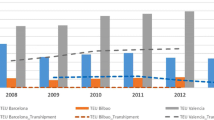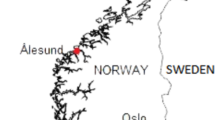Abstract
The Caribbean basin lies at the cross roads of major east-west and north-south liner shipping routes. A number of regional ports have been able to take advantage of their geographical position. In other ports, however, the limited scale of hinterlands and the de facto monopolistic situation of ports in Small Island States have had a detrimental effect on port development. Port infrastructure endowment varies between highly equipped global transhipment hubs and rudimentary ports with wooden quays. By the same token, the supply of regular shipping services ranges between highly interconnected routes on the one side, and Small Island States that are heavily dependent on a few limited feeder services on the other. At the same time, freight rates in the region dispose of a high variability. The paper analyses the impacts of port infrastructure and liner shipping connectivity on intra-Caribbean freight rates. The structure of liner shipping services, port infrastructure endowment and liner shipping freight rates are closely related to each other. The paper will analyse these relationships. The empirical methodology includes principal component analysis and ordinary least-squares regressions.
Access this article
We’re sorry, something doesn't seem to be working properly.
Please try refreshing the page. If that doesn't work, please contact support so we can address the problem.



Similar content being viewed by others
Notes
Including the following countries: Antigua and Barbuda, Barbados, Belize, Colombia, Costa Rica, Dominica, Dominican Republic, Grenada, Guatemala, Guyana, Haiti, Honduras, Jamaica, Mexico, Panama, St Kitts and Nevis, St Lucia, St Vincent and the Grenadines, Suriname, Trinidad and Tobago, Venezuela, RB.
References
Anderson, JE and van Wincoop, E . 2004: Trade costs. Journal of Economic Literature XLII: 691–751.
Angeloudis, P, Bichou, K, Bell, M and Fisk, D . 2006: Security and reliability of the liner container shipping network: Analysis of robustness using a complex network framework. Presented to IAME 2006 Conference, Melbourne.
Bichou, K . 2004: The ISPS code and the cost of port compliance: An initial logistics and supply chain framework for port security assessment and management. Maritime Economics and Logistics 6: 322–348.
Clark, X, Dollar, D and Micco, A . 2004: Port efficiency, maritime transport costs, and bilateral trade. Journal of Development Economics 75: 417–450.
Containerization International Online. www.ci-online.co.uk.
Fuchsluger, J . 1999: Analysis of maritime transport costs in South America. Unpublished Master's Thesis. University of Karlsruhe, Germany.
Harding, A and Hoffmann, J . 2003: Trade between Caribbean Community (CARICOM) and Central American Common Market (CACM) countries: The role to play for ports and shipping services. Serie de la CEPAL 52, Santiago de Chile, May.
Hernández Cruz, L . 2006: Intraregional trade and liner shipping services in the association of Caribbean states. Unpublished Masters Thesis, Erasmus University, Rotterdam.
Hoffmann, J . 2002: El costo del transporte internacional, y la integración y competitividad de América Latina y el Caribe. Boletín Fal No. 191, July 2002. United Nations ECLAC, Santiago.
Hummels, D . 1999: Toward a geography of trade costs Mimeo, University of Chicago, Chicago, United States.
Hummels, D . 2000: Time as a trade barrier Mimeo, Purdue University, October.
Hummels, D . 2001: Have international transport costs declined? Journal of International Economics 54: 75–96.
Kent, P and Ashar, A . 2001: Port competition regulation: A tool for monitoring for anti-competitive behaviour. International Journal of Maritime Economics 3: 27–51.
Kumar, S and Hoffmann, J . 2002: Globalization, the maritime Nexus. In: Grammenos, C.Th. (ed.). Handbook of Maritime Economics and Business. LLP: London.
Limao, N and Venables, A . 2000: Infrastructure, geographical disadvantage, and transport costs and trade. World Bank Policy Research Paper 2257, Washington, DC: The World Bank.
Linnemann, H . 1966: An econometric study of international trade flows. North Holland Publishing Company: Amsterdam.
Marquez-Ramos, L, Martínez-Zarzoso, I, Pérez-García, E and Wilmsmeier, G . 2006: Determinants of maritime transport costs. Importance of connectivity measures Presented to International Trade and Logistics Conference, Le Havre.
Martínez-Zarzoso, I, García-Menéndez, L and Suárez-Burguet, C . 2003: Impact of transport costs on international trade: The case of Spanish ceramic exports. Maritime Economics & Logistics 5: 179–198.
McCalla, R, Slack, B and Comtois, P . 2005: The Caribbean basin: Adjusting to global trends in containerization. Maritime Policy and Management 32: 245–261.
Notteboom, T . 2006a: The time factor in liner shipping services. Maritime Economics and Logistics 8: 19–39.
Notteboom, T . 2006b: Traffic inequality in seaport systems revisited. Journal of Transport Geography 14: 95–108.
Pöyhönen, P . 1963: A tentative model for the volume of trade between countries. Weltwirtschaftliches Archiv 90: 93–99.
Radelet, S and Sachs, J . 1998: Shipping costs, manufactured exports, and economic growth. Mimeo, Paper presented at the American Economic Association Meetings, Harvard University.
Sánchez, R, Hoffmann, J, Micro, A, Pizzolitto, G, Sgut, M and Wilmsmeier, G . 2003: Port efficiency and international trade: Port efficiency as a determinant of maritime transport cost. Maritime Economics and Logistics 5: 199–218.
Tinbergen, J . 1962: Shaping the world economy Suggestions for an international economic policy, Twentieth Century Fund, New York.
UNCTAD. 2006 Transport Newsletter, various issues: http://extranet.unctad.org/transportnews.
Wilmsmeier, G . 2003: Modal choice in South American freight transport: Analysis of constraint variables and a perspective for diversified modal participation in South America Unpublished Master's Thesis, Technische Universität Dresden.
Wilmsmeier, G, Hoffmann, J and Sánchez, R . 2006: The impact of port characteristics on international maritime transport costs. In: Cullinane, K and Talley, W (eds). Port Economics, Research in Transportation Economics Vol. 16 Elsevier: Amsterdam.
Wall, HJ . 2000: Gravity model specification and the effects of the Canada-U.S. border Working Paper 2000-024A, Federal Reserve Bank of St. Louis.
Wilson, J, Mann, C and Otsuki, T . 2003: Trade facilitation and economic development World Bank Policy Research Working Paper 2988, Washington.
Acknowledgements
We acknowledge important contributions in putting in the data gathering and initiation of this research by Lester Hernandez, during his internship with UNCTAD in summer 2006, and Omar Salgado, S&W Maritime Knowledge Network, for gathering data on the structure of liner services in the Caribbean.
Author information
Authors and Affiliations
Rights and permissions
About this article
Cite this article
Wilmsmeier, G., Hoffmann, J. Liner Shipping Connectivity and Port Infrastructure as Determinants of Freight Rates in the Caribbean. Marit Econ Logist 10, 130–151 (2008). https://doi.org/10.1057/palgrave.mel.9100195
Published:
Issue Date:
DOI: https://doi.org/10.1057/palgrave.mel.9100195




